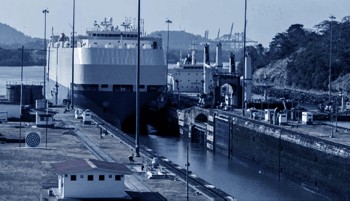08-31-2023 CHUCK HOLTON
PANAMA – The Panama Canal, a lifeline for global trade, is now facing one of its most challenging periods due to a severe drought.
It’s a sight not often seen: over 130 ships sitting at anchor off the coast of Panama, waiting their turn to transit the canal. Some may sit here for 10 days or more, or will have to offload weight to get through the canal. This congestion is a result of severe drought affecting Panama due to the El Nino weather cycle. The effect on shipping has been significant leading to ship weight restrictions and fewer daily crossings.

The Panama Canal Authority said it is limiting traffic to 32 daily ship transits through the canal after months of drought and expect less income in 2024 due to the ongoing water crisis. (AP Photo/Arnulfo Franco)
At a recent press conference, the Panama Canal Administrator spoke on the subject, pointing out that they are doing everything they can to reduce the more than 50 million gallons of water the canal uses every day.
Panama Canal Administrator Ricaurte Vásquez Morales said, “The fact is that water variability is different, the rainfall pattern is different and now it is necessary to adjust to a reality that is not necessarily solved by a reservoir.”
Consider this. In an average year, Panama receives upwards of 12 feet of rain. We got almost a foot here just yesterday. Last year? Some areas got more than 19 feet. But here’s the catch. The Canal has no mechanism to store excess water from wetter years. So, when they get too much rain, it just gets released out to the ocean. And with rainfall down by nearly 50% this year, it’s causing a serious bottleneck, affecting a significant portion of products bound for the U.S. East Coast.
“The depth, the severity of this crisis is really atypical, it is very high, so we think that between now and September 30 of next year we have to operate with drought restrictions,” Morales said.
Morales also tried to reassure the crowd that the canal will continue to be profitable. Panama’s government is worried that continued dry conditions could be a disaster for the whole country since tolls from the canal make up more than 75% of annual revenues for the Panamanian government.
He said, “International trade will always continue, so we are going to be here and produce many benefits for the country, from environmental protection to the transit of ships, we are going to be an example of economic success with social and environmental responsibility.”
The height of the rainy season doesn’t arrive until October, but if the low rainfall numbers continue, the U.S. may need to brace for further disruptions to the supply chain.
